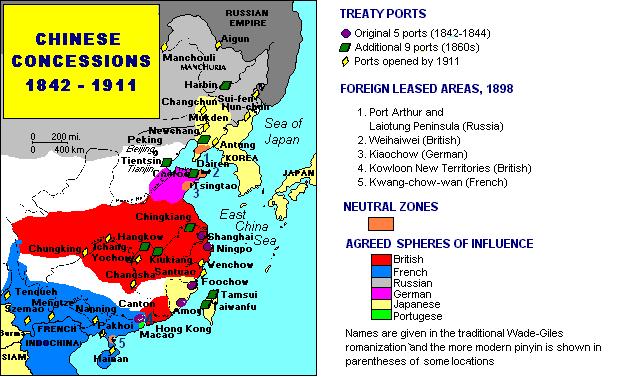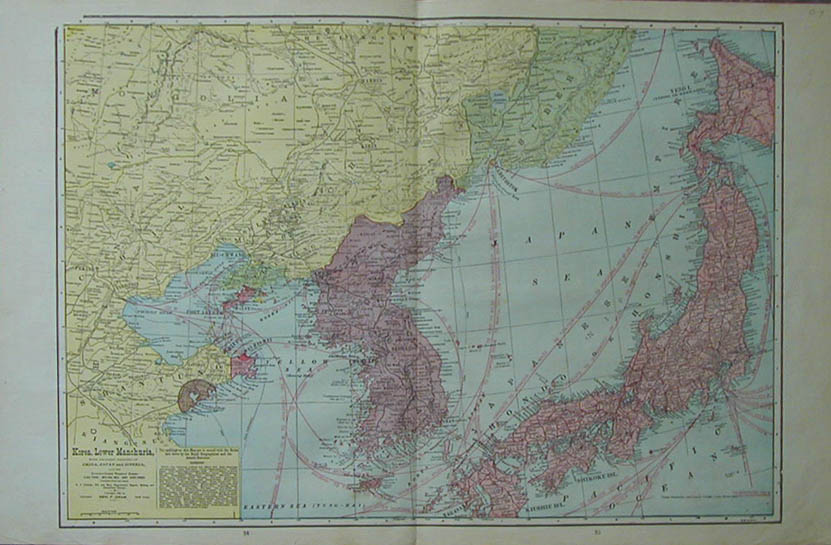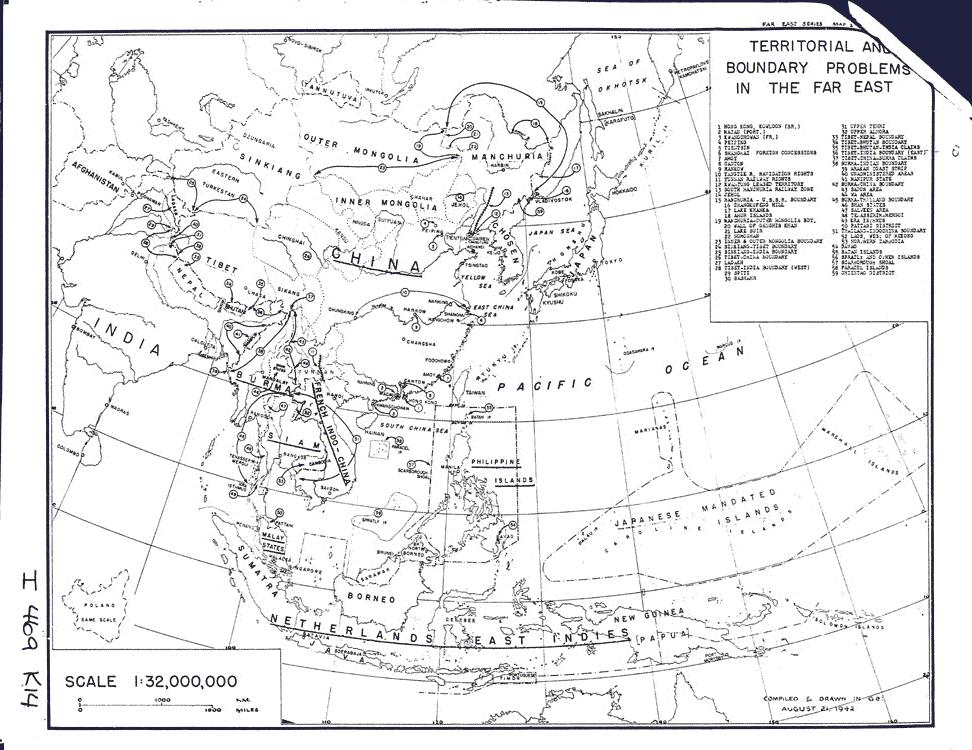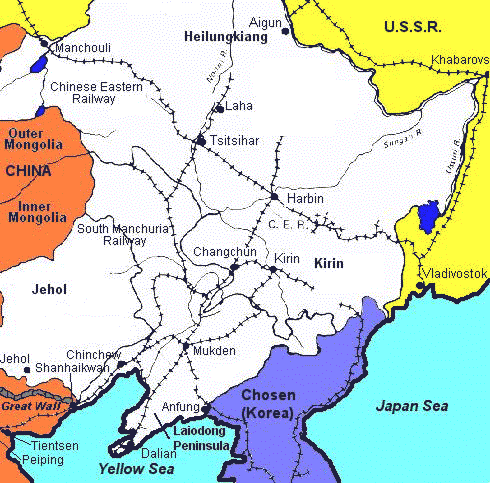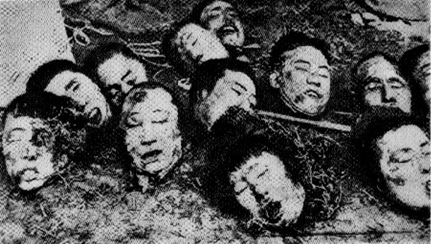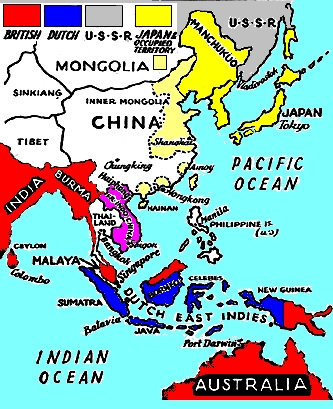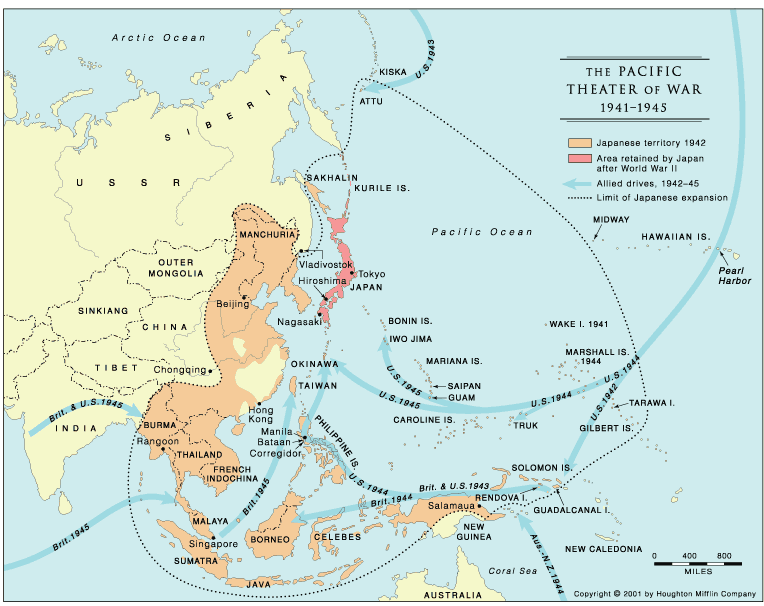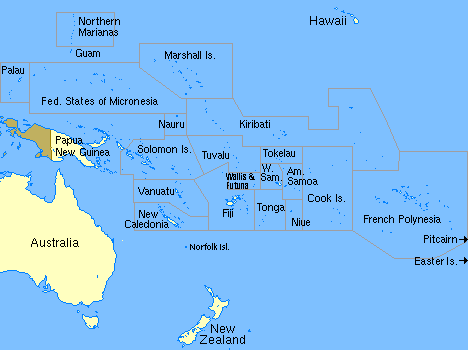Japanese Foreign Policy With Regard To Territorial Expansion 1875-1941
We will step aside from our narrative history about Wake Island to take a look at events that will effect the atoll. We will look at Japanese foreign policy during the years between before the Spanish American War to just before the attack on Pearl Harbor. The following is taken from a number of sources.
After the un-invited opening of Japan by the West, Japan found it had to find ways to deal with westerners and their way of doing things. There were events between the western countries that spilled over into relations with Japan. The western countries were colonizing areas all around the world and Japan wished to preserve what it considered its sphere of influence, particularly the islands near Japan, and Korea. Both China and Russia were beginning to place pressure on these areas Japan considered important to its national existence.
Russia with the fur trade in Sakhalin and on into the islands north of what was then Japan proper including that which has become Hokkaido was considered an intrusion and with the building of the trans - Siberian railroad it was obvious it was only going to get worse. Japan secured a treaty with Russia in 1875 yielding any claim to the Sakhalin peninsula in return for possession of all the Kurile Islands all the way to the Kamchatka peninsula. Previously Japan controlled only the Kurile islands up to Etorofu.
In 1879 Japan, which had previously weaned the Ryukyu Islands away from China by placing a strong Japanese presence on the islands, officially declared them Japanese territory as the Okinawa Prefecture.
Pressure with China and Russia was thus relieved in two areas that had been a problem between the nations and Japan. One area was un-resolved, Korea.
In 1882 there was what was called the Imo Military Rebellion in Korea when elements of the Korean military participated in a situation that led to a faction in Korean politics which looked to China for support taking control of the Korean government. When China came under attack by the French in 1884, Korean politicians of the reform or Independence Party which was supported by Japan led a coup d'etat at Hansong (Seoul). This was quickly suppressed by Chinese troops. Japanese troops were sent. Both sides backed off and signed the Tianjin Convention which cooled the situation for the short term.
In 1894, a large peasant rebellion against corruption arose in Cholla province on the lower western side of Korea on the Yellow Sea. China again sent in troops. The Japanese seeing this as a provocation sent in its own troops. This led to a war with China which Japan won. Japan successfully invaded Korea, the Liaodong and Shandong peninsulas of China before China halted the war. In the Treaty of Shimonoseki signed in 1895, China agreed to grant Korea its independence, cede to Japan the Liaodong peninsula, Taiwan, the Pesacadores (islands in the strait of Taiwan), pay a large indemnity and open several Yangtze river ports to Japanese shipping.
Russia reacted quickly to the treaty by asking France and Germany to assist in calling for Japan to give up the provision asking for the Liaodong peninsula. This was done in an act known as the Tripartite Intervention. The Japanese accepted the objection in return for an even larger indemnity from China but held antipathy toward Russia for interfering.
The western countries noting China's weaknesses in the war pushed China for concessions. The Russians, the Japanese noted with anger, established leased territory on Liaodong peninsula. The Japanese obtained a lease right on the China mainland (Fujian) opposite its new possession, Taiwan. Other countries receiving such concessions were France (Indochina and Chinese area north) and England (Hong Kong, Kowloon, Guandong, an area on the mainland opposite Hong Kong and a large area either side of Hangchow and continuing inland more than 600 km) and Germany (Shandong peninsula).
Japan assisted the European powers in sending troops to participate in the relief column that broke up the Boxer siege of the diplomatic compound in Peking. When the Boxer Rebellion was suppressed by the Allied troops they remained in China, each sending them to protect their concessionary areas.
The Russians occupied Manchuria after the Boxer Rebellion in 1900 and placed pressure on Korea. Japan attempted to trade recognition from Russia that Japanese had political hegemony over Korea in return for the Japanese stating that Manchuria lay outside of its sphere of interest.
The English, in hopes of checking the Russian expansion in Asia, concluded an alliance treaty with Japan in 1902.
No agreement was reached with Russia over their troops staying in Manchuria and the Japanese attacked the Russians on Liaodong and at Mukden (now Shenyang) as well from Korea. The Russians transferred their Baltic Fleet to the Orient to win the war but the Japanese countered in the Tsushima strait which separates Japan and Korea with a brilliant victory.
Neither side having the resources to continue the war, the Japanese prevailed on the United States to intervene and mediate a peace agreement. This was done by President Theodore Roosevelt. The Treaty of Portsmouth was signed in September of 1905 in Portsmouth, New Hampshire. Korea was recognized as being under Japanese hegemony and the Russian possessions on Liaodong peninsula were ceded to Japan as well as a railway there and the southern half of Sakhalin peninsula and certain fishing rights off Russia. Japan had also asked for indemnities but Russia would not yield any. The railway went from Lushun (Port Arthur) all the way up the Liaodong peninsula on into the interior of Manchuria above Mukden.
Japan immediately consolidated its hold on Korea though a series of agreements with Korea whereby Japan assumed Korea's foreign relations, domestic affairs and military affairs and disbanded the Korean army. In 1910, Japan concluded the Japanese-Korean Annexation Treaty whereby Korea became a part of Japanese territory. All during this time the Japanese military dealt harshly with any Korean demonstrations against this. Japan also concluded an agreement with Russia which divided the two countries spheres of influence in Manchuria and Inner Mongolia. The operation of the Manchurian Railway by the Japanese from the Liaodong peninsula on into Manchuria became a vehicle to control Manchuria.
After the Russo-Japanese War, the Japanese began to earn respect and wariness from the European powers. While England was willing to continue its alliance, the United States and others were questioning Japan's action in Manchuria.
Drawing of the Japanese Emperor Taisho leading his troops in the early 1900s.
In 1912, the most immediate flash point was generated not by Chinese, Koreans, Russians or the Europeans but by Californians.
The Japanese, after the Russo-Japanese War began to adopt at a quicker pace, much of the western styles and way of life. Some wished to go to the source of the new way. Emigration to the United States increased and the Japanese congregated in Hawaii and California.
Beginning in 1884 when Hawaiian sugar plantations concluded an agreement with the Japanese government for immigrant labor, Japanese immigrants came in greater volume than before to the United States. Many of those going to Hawaii to work moved on to California so that in 1890 of 2, 038 Japanese in the United States -1,114 of them lived in California.
California did not react well to the growing numbers of Japanese coming into the state. In fact, the State of California attempted to find ways to discourage the immigration and to find ways to have those who had made the trip, to return to Japan. To diffuse the situation the two countries made a "Gentleman's Agreement" to halt the immigrant labor program from Japan to the United States.
A provision in the agreement allowed the wives and children of the mostly male Japanese population in the United States to join their husband/father. This also included those Japanese men in the United States that were not married to have a "mail order" wife come over. The net result was the Japanese population in the United States grew rather than declined, as the sponsors of the agreement had wanted. This led to the formation of such groups as the Asiatic Exclusion League and other such groups.
In 1906, the San Francisco School Board required all Japanese and Korean children to join the Chinese children in attending school at the segregated Oriental School that had been founded in 1884.
The outright prejudice seen in these and other acts in California developed into a diplomatic issue between the two countries.
In the Spring of 1913, matters between the United States and Japan suddenly escalated to the precipice of war. The event that brought things to a head was The State of California had passed a law forbidding Japanese to own or lease land in that state. The Japanese government saw this as an insult and asked Washington D. C. to intervene.
Their note to the U. S. government called the California act "obnoxious, discriminatory, unfair, unfriendly and in violation of the treaty between the two countries." President Wilson found the tone of the Japanese note strident and unfair and asked Secretary of State William Jennings Bryan to tell the Japanese he found their note "objectionable" and to explain the relationship of the United State's Federal government to the separate states to the Japanese.
The Japanese felt the United States was being intransigent and matters grew worse. Josephus Daniels, President Wilson's Secretary of the Navy noted that many feared the long-predicted war between Japan and the United States would ensue. A New York City newspaper reported that the Joint Army and Navy Board were preparing for a war with Japan. Orders had been given to move ships, men and material in place. When asked why, the military responded that the Japanese notes were becoming more "insistent."
All this was news to the President who called a Cabinet meeting to discuss the facts. The Secretary of War, Lindley M. Garrison, defended the action of the Joint Board saying the Army and Navy had a duty to strengthen U. S. forces in the Philippines and Hawaii to prevent Japan from just taking them. By taking these actions "We were serving notice that any hostile action would be met."
Secretary of State Bryan said that "military officers were the last men to determine the policies of the government". "While we were discussing how to prevent a threatened war, these men were busying themselves with plans to get us in. It is time enough for the Army and Navy to make plans when the Commander in Chief call upon them to do so."
President Wilson dissolved the Joint Board and the Japanese Ambassador was told the administration had no thought of war and the board's action was without authorization, that the United States intended to pursue peaceful negotiations to work out all problems it may have with the Japanese.
All this not withstanding, Admiral Bradley Fiske together with Richard Pearson Hobson, a member of the Naval Affairs Committee, continued to lobby the Secretary of the Navy that Japan was planning to make war on America and steal a march on us by taking the Philippine Islands and going on to Hawaii. Pearson, a U. S. Congressman from Alabama had been an officer and a hero in the U.S.Navy in the Spanish American War. He subsequently was awarded the Medal of Honor for his valor at the Battle of Santiago Harbor, Philippines.
For many years Congressman Hobson in his speeches and appearances warned of an attack by the Japanese and called for vigilance and armament. He was so adamant on the issue that his critics were able to label him a "Chicken Little´ or the little Congressman who called wolf. As nothing did happen, the effectiveness of his warnings began to wane.
When World War I engulfed Europe, England which had signed the alliance with Japan asked the Japanese to join in the war against Germany. Seeing an opportunity to expand its influence in Asia, Japan agreed and seized the German bases on Shandong peninsula and the South Pacific Islands under German control north of the equator. Australia and New Zealand took those south of the equator.In 1915, China fell into civil war. The Japanese reinforced their armies in the Shandong and Liaodong peninsulas, they also loaned China a great deal of money and presented China with 21 Demands. If China had agreed to the demands it would have been reduced to a puppet government of Japan, but they drew out negotiations and the European and United States government lobbied with China to maintain the Open Door Policy on China. The U.S. signed the Ishii-Lansing Agreement in 1917 that recognized Japan's special interests in China, and maintained China's independence.
Map of Japan in 1915 showing Korea, the Liaodong peninsula and parts of the Shandong peninsula under their control
In 1917 when the Russian revolution became a civil war, the United States, Britain, France and other countries sent expeditions into parts of Russia to insure stability. Japan sent troops into Siberia. While the allies withdrew after WW I, the Japanese did not withdraw from Siberia until 1922.
At the Versailles peace conference after the defeat of Germany in World War I, Japan as a member of the Allied Powers (U. S., France, England, England and Japan) asked that its possessions gained in the war be sustained. This was done. The Treaty of Versailles also called for the founding of the League of Nations. Japan became one of its principal founders in 1920. The League of Nations endorsed the Japanese possession of the former German South Pacific Islands under a mandate to Japan to protect and preserve them.
Move map to the right to see the location of "The Mandated Islands"
A number of treaties followed the Treaty of Versailles to defuse potential problems around the world. These treaties included: The Four Power Treaty, the Nine-Power Treaty, the Washington Naval Disarmament Treaty, the Kellog-Briand Pact and the London Naval Limitation Treaty. The last signed in 1930.
These treaties restricted the types of fortifications that could be built by member countries, the types and number of ships they could build and maintain. Japan and the western powers backed out of China and recognized its sovereignty. Among the provisions of the Four Power Treaty was to maintain the status quo with regard to the Pacific islands.
In 1927 there was a government change in China that led to a nationalist movement. The Japanese sent troops into China to protect Japanese interests on Shandong peninsula. Between 1927 and 1928 the Japanese sent troops to Shandong three separate times.
The map shows Manchuria in white. Notice the location of the South Manchuria railroad controlled by the Japanese and the Chinese Eastern Railroad operated by Chinese and Russian interests. The Japanese used both railroads to move there troops into the upper interior of Manchuria in 1931.Anti - Japanese feelings were strong in China and the Japanese found themselves under attack. There was a large Japanese army in Manchuria ostensibly to protect the Manchurian Railway but effectively controlling major parts of Manchuria. It was receiving no reinforcements like the Japanese military in Shandong. Reacting to pressure within and outside Manchuria the Japanese Army in Mancuria decided to take the offensive. The Japanese Army in Manchuria (the Guandong Army or sometimes called the Kwantung Army)) rather than allow the new Chinese government to take advantage of unrest among the native population went on the offensive and attacked Chinese positions in several areas bordering and in Manchuria. This became known as the Manchurian Incident. The Japanese government, at first asked that the operations be stopped, but then waited and watched to see how it would resolve itself.
Red shows Japanese advances.
The Japanese Army in Manchuria took complete control and in 1930 declared the foundation of the state of Manchukuo with all government affairs in the hands of the Japanese. China appealed to the League of Nations for assistance in reversing the situation in Manchuria. The League debated the issue and sided with China. The League of Nations expected Japan to not support events in Manchuria.
A change of governments in Japan reflected public opinion in support of the Japanese army in Manchuria and began to support it with military actions and formally recognized Manchukuo.
The League of Nations in 1933 recognized Chinese sovereignty over Manchuria and asked the Japanese to support that. A resolution calling for Japanese withdrawal was put forward passing with a vote of 42 - 1. The lone dissenting vote was that of Japan. The next month Japan withdrew from the League of Nations, abrogated most of the post WWI treaties, kept the Mandated Islands stating they were now Japanese territoryand began an arms build up.
Internally the government of Japan became militarized. An active Admiral in the Japanese Navy became the Prime Minister. The new government began a drift that led it to ally with Germany and Italy and the Tripartite Anticomintern Pact of 1937. Japan began to expand from Manchuria into Northern China.
This led to another war with China. China had been in the midst of a civil war between the communists and the nationalists but they united in face of a Japanese invasion of Chinese territory. The Japanese were successful in moving south. When they reached Nanking, two events shocked the world.
The American gunboat, USS Panay, which patrolled the Yangtze River near Nanking (Nanjing), China, was used as a bomb shelter for foreign embassy staff during the Japanese bombing of the area. On December 12, 1937, Japanese warplanes suddenly and without provocation dive-bombed repeatedly the Panay and a British gunboat, both of which were moored in the river; the American vessel was sunk, and the British one severely damaged. The US public was outraged by this attack, which caused two deaths and 48 casualties. Claiming its pilots had not seen the US flags painted on the Panay's decks and sides, Japan apologized and paid the indemnity demanded by the United States.
Another incident of the Japanese attacks from North China into South China involved a situation that has been termed as the Rape of Nanking when Japanese soldiers, unrestrained by their leaders entered the open city that did not resist them and laid to waste the people and the city with atrocities that to this day evoke strong reaction on both sides of the issue. The Japanese had been brutal in their campaign in China not just at Nanking but everywhere, but in Nanking - the very worst of man's inhumanity toward man was displayed.
In Europe WWII exploded. The Japanese, taking advantage of their alliance with Germany and Italy attacked English, French and Dutch possessions in South East Asia in 1940. When Germany attacked Russia in June of 1941, Japan moved to go to war with Russia. In October of 1941, rightist General Tojo was the leader of the Japanese government.Having to decide to carry the war to the north (Russia) or to the south (the southeast Asian possessions of Britain, France and the Dutch). Japan chose going south and began the policy of the Greater East Asian Co-Prosperity Sphere, encouraging national independence movements among the Asians and seeking their cooperation in the war. In reality Japan was after natural resources: oil, rubber, bauxite, and other resources not found in Japan and preparing for the bigger war they knew was coming with the United States.
The Pacific Islands as they are organized today is shown below:

